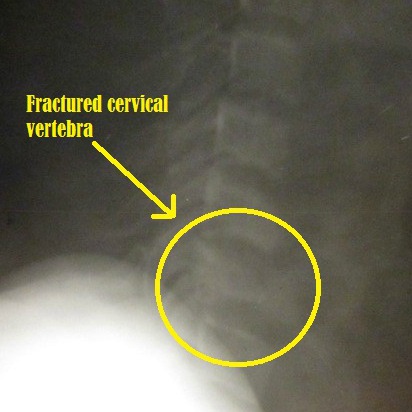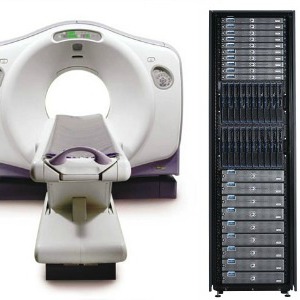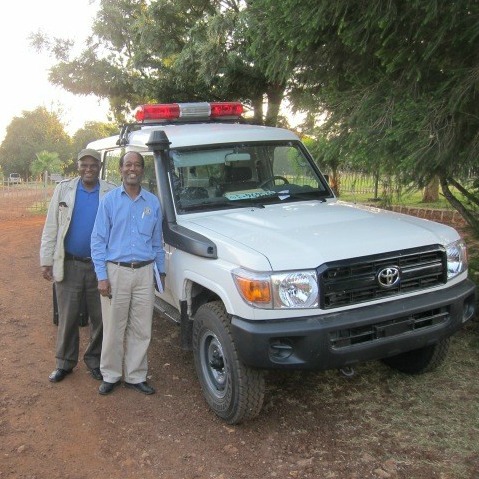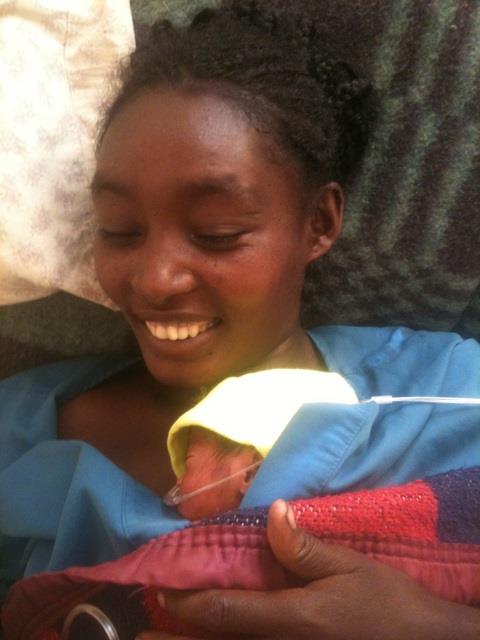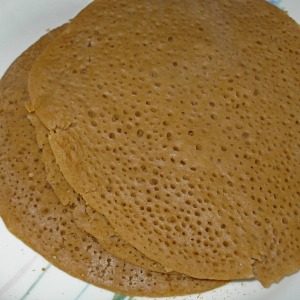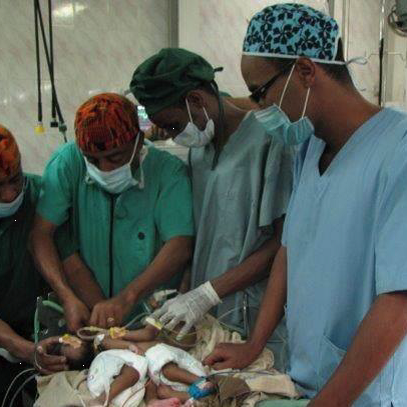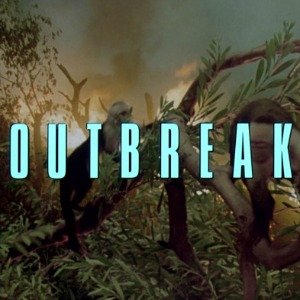To Walk Again
ጥር 23, 2014Medical Care,Patient Stories
This is what a broken neck looks like:
About seven months ago, a 17-year old young man came to us after an injury. What you see above is his actual x-ray. He had been in a tree, and fallen quite a distance. He had a fractured femur, but worse than that he had a broken neck that had caused paralysis. He could not move his arms or legs, and only had some preserved sensation in his extremities. We surgically repaired his leg and his neck, and he was in the hospital for one month recovering. Sadly though, even at the time of his discharge, he was barely moving his fingers and toes. We were unsure if he would ever walk again.
Recently, the young man returned for his follow-up. Praise the Lord that he is now almost fully recovered. He has almost full strength in his arms and hands, and can run on his own two legs. A paralytic healed! Here he is pictured below with Dr. Anderson.
The best part of the story is this. This young man was quite poor. He was unable to pay for his care. But because of generous donors to the Benevolent Fund, his surgeries and post-operative care were paid in full. Because people like you care enough to give, we were able to medically care for him. By God's grace, he is healed and planning to return to school later this year.
Help us treat more patients like this! Our Benevolent Fund relies on donors like you. And 100% of every dollar goes to fund patient care. We are looking for 100 donors to pledge $100 per month for the next year. These funds will help us to cover the costs of our poorest patients. You can set up a recurring gift through our secure site here. God bless you!
What Will $100 Buy at Soddo Christian Hospital?
Getting lost in all the talk about Obamacare and health insurance? Want to see some real information on what we can do with $100?
Soddo Christian Hospital is saving lives in southern Ethiopia, and spreading the Gospel of Jesus Christ through evangelism and discipleship. A hundred bucks will go a long way in our hospital! Here are a few examples:
- An appendectomy for $100?? You bet. In the US, it costs around $30,000 to take out the old appendix. But here, we do it for around $100. This is a pretty common malady, especially among young people. And it's a "bread-and-butter" surgery that our residents need to learn.
- Sometimes a surgery isn't needed. We see a lot of pediatric patients that just need some antibiotics and to drink plenty of fluids. They might have a mild pneumonia or a little gastrointestinal illness. Also, we sit and talk with mom about what's going on. (Doesn't sound novel, but in this culture, parents don't often get a lot of information about what's going on.) In the US, just one trip to the doctor with your kid would cost $100. But in Soddo, we can see about 20 patients for that.
- If admission to the hospital is required, we can do that. We have over 100 beds for inpatient care of all types - pediatric, adult, medical, surgical, obstetric, and the list goes on. In some countries, a hundred dollars wouldn't even pay for 3 hours of care. At Soddo Christian Hospital, that will cover more than 3 days of inpatient care.
- Having a baby? A hundred dollars will pay for a Cesarean section and the associated care... completely! In the West, this would cost $5,000. We can do 50 C-sections for that. In this country, women die during childbirth due to inability to get a C-section. Not long ago, an Ethiopian woman had a 1 in 15 chance of dying in childbirth. Now, it's down to 1 in 67 because of improving health care. (But still a long way from the rate in the US: 1 in 2,400).
- We are passionate about teaching. We believe that medical mission hospitals have a duty to train the next generation of providers in the country they serve. And we are doing just that. We have residents and medical students working and learning at the hospital, and all being influenced by the Gospel during their time here. For a hundred dollars, we can provide medical textbooks and learning materials for one of those residents to use. That's the gift that keeps on giving.
We have begun our 100 for 100 campaign, and these are just a few examples of what that hundred bucks will buy! We are looking for 100 donors to the hospital Benevolent Fund to cover costs of care for our poorest patients. The pledge is 100 bucks a month for a year. And you can rest assured that one hundred percent of your gift will go to fund patient care!
100 Giving $100
ጥር 10, 2014General,FAQ,Fundraising
We need your help! In the next 100 days, we want to find 100 donors to give $100 per month for a year!
The care at Soddo Christian Hospital is subsidized for our poorest patients. We have a Benevolent Fund which offsets the cost, so that all patients receive the highest standard of care we can provide, without respect to their ability to pay. Many amazing stories of physical and spiritual healing have taken place within this hospital because of the Benevolent Fund. We post the stories on this blog as often as we can. Read one such story here.
In order to make this subsidy available, we need donors for the Benevolent Fund. We have set out to recruit 100 donors who would be willing to give $100 per month for the next year. We can set up an ongoing, recurring donation using the link on our Donate page.
And you can give with confidence, because 96% of your gift will go directly to patient care! Please sign up today, and tell a friend. Our goal is to find 100 such donors in the next 100 days. Won't you help us?
Servers and Soddo
ታህሳስ 30, 2013Medical Care,Guests
Take a look at these photos:
These are not things that you might be used to seeing in a mission hospital. But the reality is that all hospitals, even mission hospitals, are getting on the technology bandwagon. We have a CT scanner that improves our diagnostics - allowing us to make more accurate diagnoses and provide better care. We have a server room and a network that extends throughout the hospital campus. That allows us to access internet and current treatment recommendations. It gives us the ability to look at digital x-rays and CT images throughout the hospital. And one day, it will allow for an electronic medical record to keep track of our patients.
The mission hospital of the 21st century is not what you thought! We've got a lot of technology, and we've got to keep it all running. If you are a network administrator, computer programmer, IT specialist - or if you know any - come and help us out! We'd love to have you for a short term visit, or longer. Contact us if you're interested.
You Can Put St.ock In Us!
Would you like to gift stock to Soddo Christian Hospital? We can accept it!
St.ock gifts are a great way to donate funds to patient care. The Foundation receives the full current value of the stock, and the donor avoids capital gains taxes. How does it work?
Well, if the securities have been held for more than one year and are donated directly to the Foundation, the donor is able to deduct the full fair market value of the securities. And capital gains taxes are avoided. On the other hand, if the securities are sold first and then the proceeds are given, the donor still has to pay capital gain taxes to the Internal Revenue Service. A little planning in this area can help you take full advantage of the tax benefits allowed by the government.
Got some stock to donate? Contact us at info@soddo.org for more information on how to make the donation?
The Ambulance Is Here!
ህዳር 29, 2013Medical Care,Fundraising
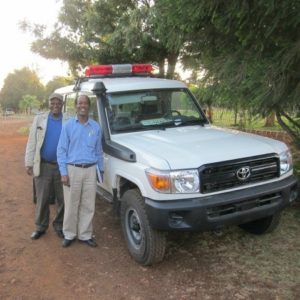 A few months ago, we posted the project for an ambulance and the need. Well, God answered our prayers, and provided the funds and now, the ambulance!
A few months ago, we posted the project for an ambulance and the need. Well, God answered our prayers, and provided the funds and now, the ambulance!
Just today, the new Landcruiser ambulance was driven down from Addis and on to our hospital grounds by our own chief administrator, Ato Desalegn. Here is Desalegn pictured with Pastor Daniel, the head of our spiritual ministries, by the new ambulance. He even fired up the siren as he pulled on campus to let everyone know.
There's a lot of excitement here around our newest addition. In Ethiopia, there are no municipal-backed EMS systems. So having an ambulance is really key for hospitals. It will allow us to transfer and go pick up sick patients. From time to time, we have had really sick patients who required a specialized operation or procedure only available in Addis Ababa. Before, we had no way to get them there, and some of these patients died. Now, we will be able to take them in our new ambulance.
An ambulance really legitimizes us in the eyes of the people of this area too. People know they will be cared for here, and if for some reason we need to transfer them, now we can!
Thanks to so many of you who helped us reach this goal. We thank God for you!
The Work of God
Two of our staff go out into the rural areas around Soddo every week to deliver much needed prenatal care. Over 95% of women in rural Ethiopia will deliver their baby with no professional attendant - midwife, nurse, or doctor. Even more than that will have no prenatal care at all. These are the reasons that we continue to see high maternal mortality and neonatal mortality in this country. (A woman aged 15 has a one in 67 chance of dying in childbirth. In the US, it is one in 2,400.)
Well our staff are doing something about it! Every week, Sophie and Jodi head out "into the bush" to tend to these pregnant ladies. Women come from all over, and line up to see them. Occasionally, they will see a critically ill mom who needs prompt attention - those get referred on to the hospital. One such woman came last Thursday.
Her complaint was that "water was coming out," and indeed she had what we call "premature rupture of membranes" - her water broke too early. She was only seven months pregnant. Not only that, but she had lost two babies before. Both at exactly the same time - seven months.
They loaded her up in the car, and brought her straight to Soddo Christian Hospital. She was seen by Dr. Mark Karnes, our obstetrician, but the situation looked grim. She was admitted, but a few days later went from bad to worse. She abrupted her placenta (where the placenta tears away from the uterus), and began hemorrhaging. It required an emergency C-section. (Dangerous for mom because of the bleeding. Dangerous for baby because these little ones often don't have developed enough lungs to survive once they are out of the womb. They lack something called surfactant which keeps the air sacs open in the lungs. Fortunately, if the mom receives steroids in the hospital, this problem can be helped.)
A beautiful little girl was born, weighing less than three pounds, but breathing on her own - only occasionally requiring oxygen support. Her mom couldn't be more thrilled, and is cuddling her close to her body to keep her warm. Something that is called "Kangaroo Care." And the new little one's name says it all - Yabsera. Literally "the work of God".
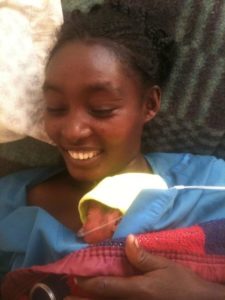
How Much Injera Do We Eat?
Ever had injera? Well, if you're reading this from Ethiopia, then the answer is "yes". But if you're anywhere else in the world, you might not have had injera. So what is it?
Wikipedia defines injera as "a yeast-risen flatbread with a unique, slightly spongy texture traditionally made out of teff flour." Teff is unique itself, almost exclusively found growing in the fields of Ethiopia. So this is a very Ethiopian food. The injera is used as an eating utensil, essentially sopping up the delicious stews (or "wots") that make up Ethiopian cuisine. A piece of injera is typically around 15 inches in diameter.
Of course our hospital goes through a lot of injera. It is served with every meal, and we serve our patients 3 meals a day. So, how much injera do we go through then? About 400 per day, or 3,000 per week. In one year, at Soddo Christian Hospital we consume over 150,000 giant pieces of injera!

SCH Graduate Makes History
ጥቅምት 21, 2013Medical Care,Patient Stories,Training
Recently, the very first graduate from the PAACS program in Ethiopia did something unique in his own country. He led a team that separated conjoined (“Siamese”) twins. To our knowledge, nothing like that had ever been attempted in Ethiopia. Dr. Frehun Ayele, who trained as a pediatric surgeon at the BethanyKids at Kijabe Hospital PAACS program after graduating from the general surgery program in Ethiopia, led a team of surgeons from Myungsung Christian Medical Center to perform the incredibly delicate and complicated operation. The baby sisters were born at a health center in the countryside and were abandoned by their mother. They were given to a Catholic mission group here who then brought them to MCM. One of the twins had a severe, fatal heart defect and it soon became clear that she could not survive. This made transfer abroad impossible because of time considerations, so Frehun made the difficult decision to take them to the operating room to separate them. It was clear that one of the twins would die, sacrificing her life for her sister's. Dr. Frehun concluded that if he did not intervene urgently, both babies would die. The surviving twin, Mariam, is doing well. Please pray for her as she recovers. We praise God for Frehun's faithfulness in serving Him as he serves the sick children of Ethiopia.


Hot Zone in Soddo
ጥቅምት 10, 2013Medical Care,Patient Stories
Last week, we had some pediatric patients come in with upper respiratory symptoms. A few of them had a rash and had been given antibiotics, so there was a thought that maybe it was a "drug-related rash." But it wasn't long before a few more kids came in, and it was clear that this wasn't a medication-induced rash. Yep, this was measles.


It didn't take long before our entire pediatric ward was full of measles patients. We were in the middle of a genuine outbreak. The feared complication of measles is pneumonia, and indeed most of the patients we were getting had it. Many have them were requiring oxygen. In the picture below, the machines on the floor are oxygen concentrators.

The health department was notified, and they began taking measures. Much of the outbreak was centered on an orphanage down the street from us. So we contacted them and gave them specific instructions. First, isolate any kids that were showing symptoms. Second, send any kids to the hospital that were showing signs of pneumonia or respiratory distress. We took a trip down to the orphanage ourselves to see the patients who were not sent to the hospital and check on them.

By God's grace, the outbreak seems to be relenting. Our hospital has admitted around 15 kids. Sadly, a few of them have succumbed to the disease. The thing about measles in outbreak settings, is that it affects the very young. Children are vaccinated against this virus between nine months and one year of age. So the most vulnerable are the babies less than nine months. Formula-fed babies (like the orphans) are particularly vulnerable because they don't get protective maternal antibodies. Fortunately, some who were very sick are pulling through. The situation itself feels like a war zone. Our doctors and our nurses are tired, but they are doing an amazing job - rising to the occasion and providing excellent care. We praise God for using us in this situation, and hope to bring Him glory through it. As it says in 1 Cor 15:58, "Be steadfast, immovable, always abounding in the work of the Lord, knowing that in the Lord your labor is not in vain." Pray that we will be steadfast. And that no more of these precious little ones will die.
The other thing about situations like this, is that it stretches our thin resources to the maximum. We don't have enough oxygen concentrators. We don't have enough pulse oximeters. And we can't mechanically ventilate kids with severe pneumonia. We hope to buy non-invasive ventilator machines, and perhaps one or two mechanical ventilators. We'd love to be even better prepared the next time this happens. Would you consider a donation today that would help us do that? Just click donate in the upper right corner of the site. Thanks for your support and prayers.

